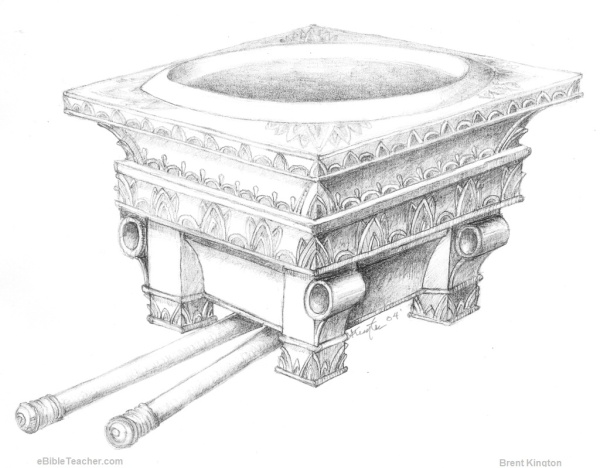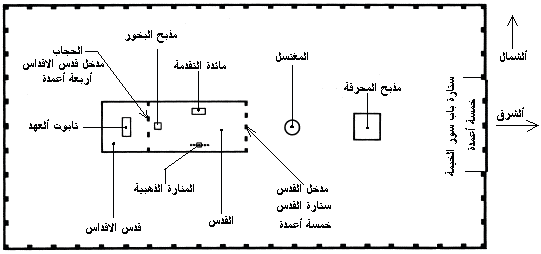The Tabernacle and what it
represents
Part 5
In this article we
will continue the explanation of the cupper laver and the fence of the
tabernacle.
(6) The cupper Laver
(Basin)

Exodus
(30 – 18): “ You shall also make a laver (basin) of
cupper, with its base of cupper, for washing. And you shall put it between
the tent of the meeting and the altar, and you shall put water in it,
19
with which Aaron and his sons shall wash their hands and their feet.
20
When they go into the tent of the meeting, or when they come near the altar to
minister, to burn an offering by fire to the Lord, they shall wash with water,
lest they die. (Otherwise they will die).
21
They shall wash their hands and their feet, lest they die; and it shall be
observed by them and their descendants for ever throughout their generations”.
(6)
The cupper Laver (Basin): The Laver and its
base were made of cupper, it was placed between the tent of the meeting and the
cupper altar. And Aaron and his sons used the water that was put in it to wash
their hands and their feet before going into the tent of the meeting, or when
they went near the altar to minister the burnt offering by fire to the Lord, as
ordered by the Lord otherwise they would die. This, they and their descendants should
and were to observe forever throughout their generations.
Sequentially God had
asked for the Laver to be made directly after the golden altar of incense. Yet
both were mentioned after the sequential descriptions and instructions of the
ark of covenant, the golden bread table, the golden lamp-stand, the tent and
its fence, and the altar of burnt offerings were given. This was not without a
good reason, for God has offered his Son to redeem us, he gave us his flesh and
blood as a bodily and spiritual food, he made us a kingdom of priests for him
throughout our generations, he explained the way of salvation to us, he gave us
a sign and a symbol for the redemption so that we may understand its meaning
and know the requirements to get it, and finally he told us how to purify our
bodies and souls. For the purification of the soul is done by praying and
thanksgiving to God, as seen clearly in:
Psalm (141
- 2):
Let my prayer be
counted as incense before you, and the lifting up of my hands as an evening
sacrifice!
And in:
Psalm (51 - 15):
O Lord, open my lips
and my mouth shall show your praise.
16 For you have no delight in sacrifices, were I to give a burnt offering, you
would not be pleased.
17 The sacrifice acceptable to God is a broken spirit, a broken and contrite
heart, O God you will not despise.
The purification of
the soul by praying to God is the most important thing, that is why it was
mentioned first. Also the cleansing of the bodies of the priests and believers
with water is essential so that they are be kept pure. As a first step the
purification of the soul and the body is essential for salvation, and then by
their redemption they can unite with their creator again. Don't forget, it was
water and blood that came from Christ side when he was crucified on the cross
to redeem us, (John-19 - 22).
The Laver was made
of the cupper of the mirrors of the women who were in the service of the tent
of meeting. Which means that instead of taking care of the outer appearance,
the believer should take care of the cleanliness of his body and the
purification of his soul before his creator, that is he should be pure from
inside and the outside.
This means that the
water that was in the Laver was but a sign for the
required baptism, which the believer does and must accept before
entering the church of God, that is to enter into the
Holy-place. Don't forget Christ washed the feet of the disciples before
the redemption as in:
John (13 -
5):
Then he poured
water into a basin, and began to wash the disciples' feet, and to wipe them
with the towel with which he was girded.
6 He came to Simon Peter and Peter said to him, "Lord do you wash my
feet?"
7 Jesus answered him, "What I am doing you do not know now, but
afterward you will understand."
8 Peter said to him, "You shall never wash my feet". Jesus
answered him, "If I do not wash you, you have no part in me."
9 Simon Peter said to him, "Lord, not my feet only but also my hands
and my head!"
10 Jesus said to him, "He who has bathed does not need to wash, except
for his feet, but he is clean all over; and you are clean, but not every
one of you."
Now we shall try to
explain the meaning of the different parts of the tabernacle, beginning from
the fence outside then the Holy-place and the Most Holy of the Holy
inside, and finally the different covers of the tent.
(7) The
Court of the tabernacle (The fence)

Exodus
(27 – 9): “ You shall
make the court of the tabernacle
(the fence). On the south side the court shall have hangings of
fine twined linen a hundred cubits long for one side;
10
their pillars shall be twenty and their
bases twenty ,of cupper, but the hooks of the pillars and their fillets (joining rods at the top) shall be of silver.
11
And likewise for its length on the north side there shall be hangings a hundred
cubits long, their pillars twenty and their bases twenty, of cupper, but the
hooks of the pillars and their fillets shall be of silver.
12
And for the breadth of the court on the West Side there shall be hangings of
fifty cubits, with ten pillars and ten bases.
13
The breadth of the court on the front to the east shall be fifty cubits.
14
The hangings for the one side of the gate shall be fifteen cubits, with three
pillars and three bases.
15
On the other side the hangings shall be fifteen cubits, with three pillars and
three bases.
16
For the gate of the court (the entrance) there shall be a screen (curtain) twenty cubits long, of blue
and purple and scarlet stuff of fine twined linen, embroidered with needlework;
it shall have four pillars and with their four bases.
17
All the pillars around the court shall be filleted (joined with) silver; their hooks
shall be of silver, and their bases of cupper.
18
The length of the court shall be a hundred cubits, the breadth fifty, and the
height five cubits, with hangings of
fine twined linen and
bases of cupper.
19
All the utensils of the tabernacle for every use, and all its pegs and all
the pegs of the court, shall be of cupper.

(7) The
Court of the tabernacle (The fence): The fence was a rectangle, On the
southern side the court had hangings of fine twined linen a hundred cubits
long, their pillars were twenty and their bases twenty, of cupper, but the hooks of the pillars and their
fillets (joining rods at the top) were of silver.
Likewise on the northern side there was hangings a hundred cubits long, their
pillars were twenty and their bases twenty, of
cupper, but the hooks of the pillars and their fillets were of silver. On the western side there was hangings of
fifty cubits, with ten pillars and ten bases. On the front in the
east, the hangings for the one side of the gate were fifteen cubits, with three
pillars and three bases. On the other side the hangings were fifteen
cubits, with three pillars and three bases. For the gate of the court (the
entrance) there was a screen (curtain)
twenty cubits long, of sky-blue and purple and scarlet
stuff of fine twined linen, embroidered with needlework; it had four
pillars and with four bases.
The hangings were
all made of white twined linen, the pillars of the fence were sixty
(Their material was not mentioned), each had a base of cupper, and all the pillars around the court were filleted
(joined with) silver rods; their hooks
were of silver. The height of the fence was five
cubits . All the pegs of the court were of
cupper.
The only entrance
to the outside court of the tabernacle was through its gate in the eastern side. All the pillars had bases of cupper and the pillars were filleted and joined
together with silver rods, which meant that all the nations outside are under the judgment of
death (cupper bases), but in the same time the
redemption hangs over their heads and is within their reach (Fillets of silver). The whole tent is a tent of priesthood
(Twined linen hangings around it) and its
entrance is only possible through its gate in the eastern
side through a screen (curtain)
twenty cubits long, of sky-blue and purple and scarlet
stuff of fine twined linen, hanged by four pillars. This means that the
entrance is only possible through a heavenly King,
a priest and a redeemer whose blood is splashed all over the
entrance to prevent the angels from destroying and killing whoever accepts
his redemption and comes under his protection. (Remember how the angels
killed all the first-born of the Egyptians, yet the blood that was touched on
the lintel and the posts of the Israelites’ doors saved all the first-born of
the Israelites). The entrance is possible through the four pillars of the
entrance for all nations, that is for all the nations of the Four Corners of the world without exception. The gate
is in the east side of the fence because Christ was crucified with His
face facing east in the direction of the temple and Jerusalem.
The
pillars represent the
condition and state of the people outside the courtyard, the bases show their actual
state as it is, but the fillets (joining
rods) and hooks indicate that they can reach and get salvation by
redemption. Here the pillars say, "All the nations
outside the courtyard are under a
judgment of death but they can be
redeemed. "
All the pegs
of the court were of cupper to indicate
that even the earth is under curse and judgment, ( …. , cursed is the
ground because of you, ….. (Genesis 3 -17).
In the next
part we shall talk about "The Holy" and " The Most Holy Of The
Holy", The
frames of the tabernacle and the side bars.
Nori
Karim Daoud
25
/ 02/ 2009
|
|
|



